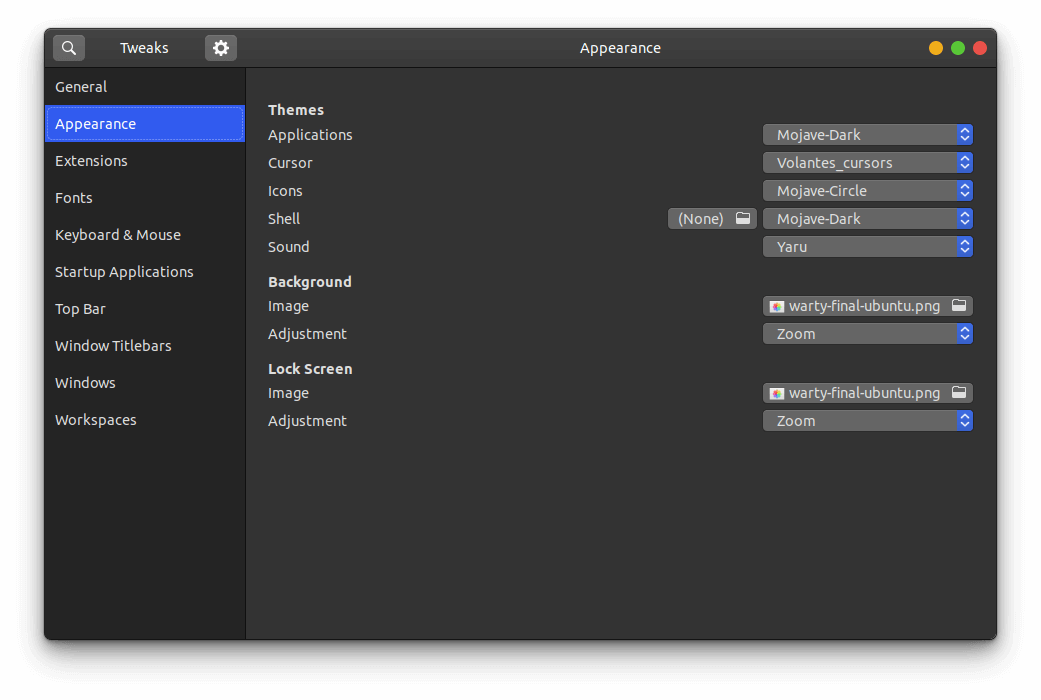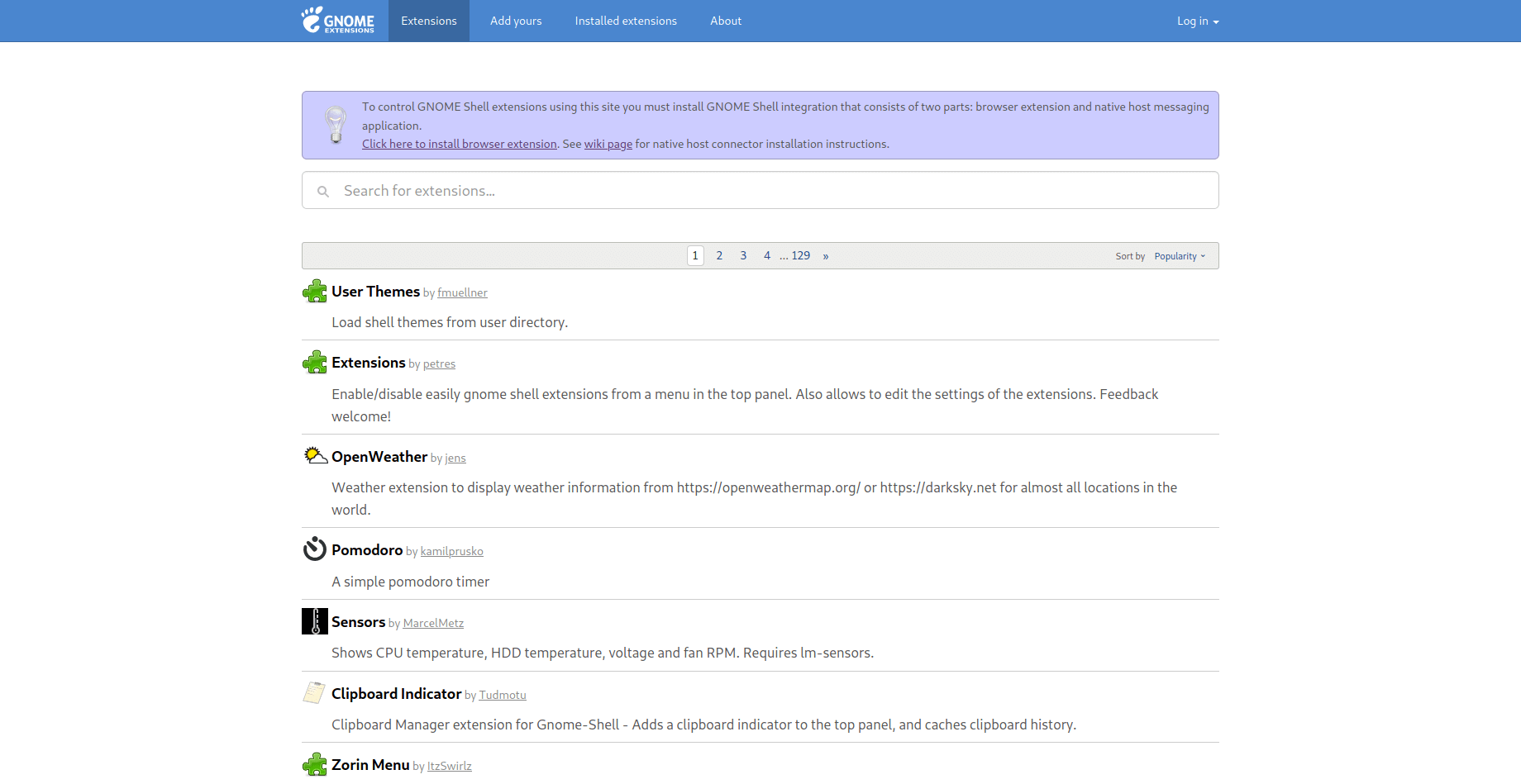More Information
For inspiration on designing your *nix computer, check out the r/unixporn subreddit!
Customizing Ubuntu
New to Linux and want to add a personal touch to your machine? One of the best perks of Linux is that it is extremely customizable. You can change the styles of the windows, shell (status bars/docks), icons, fonts, terminals, and more.
In this post, I'm going to go through customization on Ubuntu 20.04 (GNOME) since most new users tend to choose Ubuntu-based distros. If you've found a way to install Arch with i3-gaps, I'm assuming you know how to find more advanced tutorials out there on customizations.
Required Tools

Ubuntu 20.04 ships with the default desktop environment
Gnome, which includes the handy gnome-tweaks tool to
quickly change designs. To install this, just open your terminal and enter the
following command:
After you've finished installing the tool, simply launch the Tweaks application, and you'll be able to access the various customization options available by default on Ubuntu. You might even like some of the pre-installed options.
GNOME Application Themes
To change the themes applied to applications in GNOME, you will need to change the Applications dropdown in the Appearance section of Tweaks. To add more themes, you will have to find your preferred theme online and follow the steps below to have it show up in the Tweaks tool. While you may find themes anywhere, one of the most popular sites for GNOME themes is gnome-look.org. This website contains themes for applications, shells, icons, and cursors.
Steps to import themes into Tweaks:
- Download the theme.
- These files are usually compressed (.zip, .tar.gz, .tar.xz), so you will need to extract the contents. This is easiest when opening the file explorer, right-clicking the compressed file, and choosing "Extract here."
- Move the theme folder to
/usr/share/themes/. You can do so with the following command:sudo mv theme-folder/ /usr/share/themes/.- Icons and cursors will be moved to the
/usr/share/icons/folder. - Fonts will be moved to the
/usr/share/fonts/folder Alternatively, you can move them to the/usr/share/fonts/opentype/or/usr/share/fonts/opentype/folders, if you have a specific font type.
- Icons and cursors will be moved to the
- Close tweaks if it is open. Re-open Tweaks and your new theme will be available in the Applications dropdown in the Appearance section of Tweaks.
If the theme is not showing up after you've moved it into the themes folder, you may have uncompressed the folder into a sub-folder. You can check this by entering the theme folder and listing the contents:
&&
This is an example of what the contents of your theme folder should look like.
If you just see another folder there, you should move that folder up into the
/usr/share/themes/ folder.
GNOME Shell Themes
To change the appearance of the title bar, default dock, app menu, and other parts of the GNOME shell, you'll need to install the user themes extension on Gnome Extensions. To be able to install extensions, you will first need to install the browser extension that the website instructs you to. See this screenshot for the blue box with a link to the extension.

After the browser extension is installed, you will need to install the native host connector:
Finally, you can go the user
themes extension page
and click the installation button. This will enable the Shell option in Tweaks.
Now you can move shell themes to the /usr/share/themes directory, using the
same steps mentioned in the previous section, and enable the new theme in
Tweaks.
Icons & Cursors
Icons and cursors are installed exactly the same way, so I'm grouping these
together in this post. Both of these items will need to follow the same process
as installing themes, except you will want to move your font folders to the
/usr/share/icons/ directory instead.
Fonts
Fonts are one of the overlooked parts of customization, but a good font can make
the whole screen look different. For example, I have installed the IBM
Plex fonts on my system. This follows the
same process as installing themes, except you will want to move your font
folders to the /usr/share/fonts/ directory instead.
Terminal
If you spend a lot of time typing commands, you know how important the style and functionality of the terminal is. After spending a lot of time using the default GNOME terminal with unix shell, I decided to try some different options. I ended up choosing Terminator with zsh.
Terminator is great if you need to open multiple terminals at one time by simply right-clicking and splitting the screen into as many terminals as you want. While this project hasn't been updated in a while, it is coming under new development. However, this terminal is great and I haven't experienced any errors yet.
For the shell choice, I decided to choose zsh after trying it out on a fresh Manjaro installation. Zsh is great if you like to change the themes of your terminal, include icons, or add plugins.
The desktop uses the
zsh-autosuggestions to
suggest past commands as you type. In addition, it suggests corrections if you
misspell a command. Lastly, it uses the af-magic theme, which adds dashed
lines between commands, moving the user@host tag to the right side of the
terminal, and changes the colors. There are plenty of plugins and themes to
choose from. Just figure out what you like and add it to your ~/.zshrc file!
Steps to Replicate My Terminal
To install zsh on Ubuntu, enter the following command into a terminal:
Then, enter the next command to activate zsh:
To install Terminator on Ubuntu:
To install Oh My Zsh on Ubuntu:
To install zsh-autosuggestions via Oh My Zsh:
Then, add the following plugin wording to your ~/.zshrc file (the default
config usually has the git plugin activated, so just add any other plugins to
the parentheses separated by a space):
plugins=(git zsh-autosuggestions)
Finally, you need to log out of your computer and log back in so your user shell can refresh.